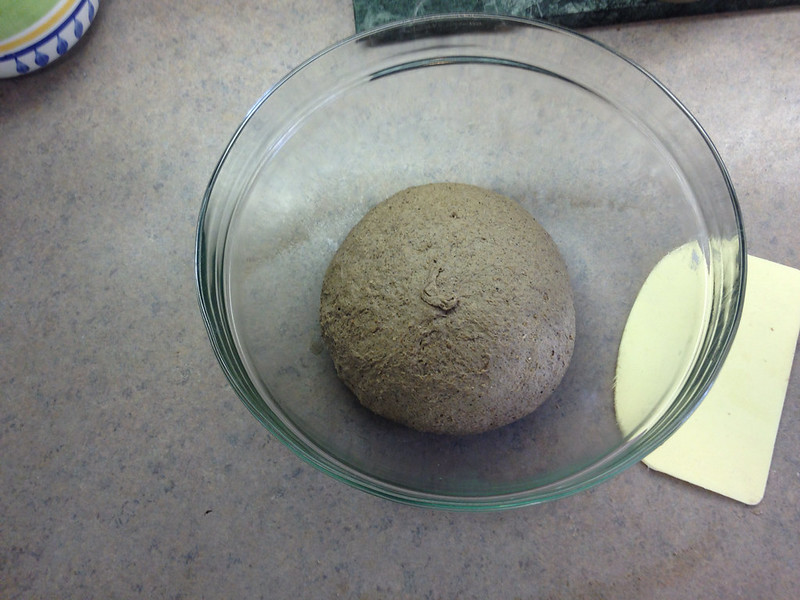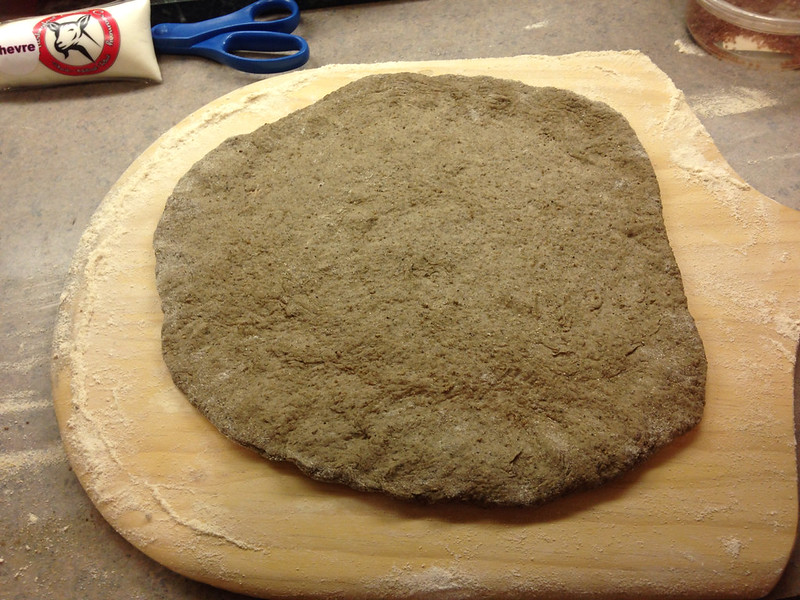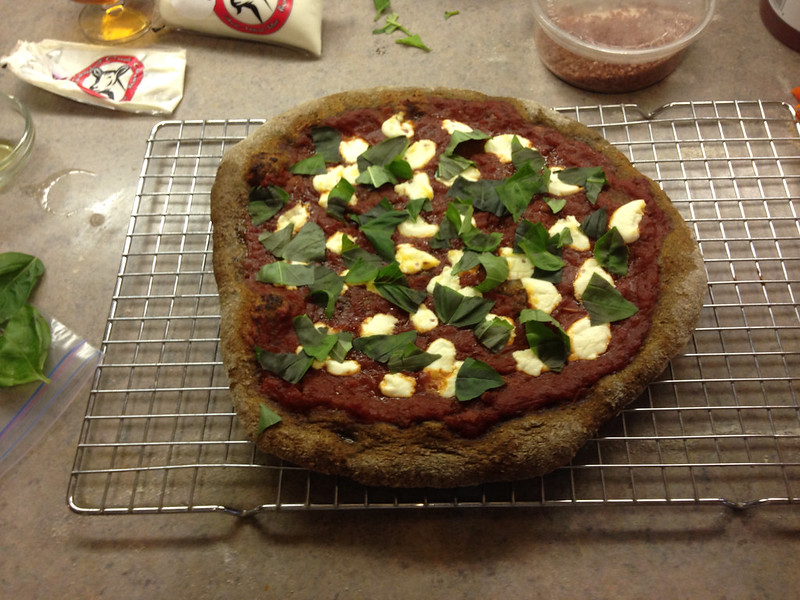You're viewing old version number 24. - Current version
Making pizza from spent beer grains
On Jul 5, 2014, I made a pizza dough that used some spent grains from our Dark-eyed Junco Imperial Stout that we brewed on Mar 30, 2014. It's probably the ugliest pizza crust ever made, but it turned out surprisingly well. The addition of the spent grains imparted a mild flavor, made a thicker and chewier crust, and added a lot of dark color.
On brew day, I placed some of the spent grains in two, thick, air-tight, plastic containers, and I placed the containers in the freezer on brew day.
A few weeks later, I pulled one of the containers from the freezer and dried the grains over about two or three day period. The soaked grains take a while to dry. I tried placing the grains in the oven for a while, but that made them wet and hot.
After the grains finally dried, I placed them into an air-tight container and placed the container in the refrigerator.
On July 5, I finally decided to try using the grains in a pizza recipe.
First, I ground some grains in our Vitamix. I pulverized the grains into a powder, but I used the Vitamix for under 30 seconds. Next time, grind for nearly a minute, since I found some twiggy-like aspects in the grains. So the spent grains are as powder as I would prefer.
The recipe:
- 110 g of spent grains, pulverized into mostly powder.
- 550 g of all-purpose flower
- 455 g of water (frig temp)
- 13 g of fine-grain sea salt
- 4 g dry active instant yeast
After grinding the spent grains, the powdery mixture was colored a dark brown.
After mixing all the dry ingredients, the mixture had the color of buckwheat flour. It was colored a medium grey.
After adding water, the mixture became a dark grey color.
I could have used more water, prob 500 g. The initial mixture produced a stiff dough. This may not ferment nor proof very puffy, and it may be difficult to stretch.
No gluten, of course, in these spent grains.
Maybe next time, try only 55 g of spent grains. Start small and work up.
Oh well. We'll see.
- autolysed for 25 minutes. afterward, the dough felt great. no need to add more water to the recipe.
- kneaded dough for a little over 4 minutes. the dough got stickier near the end.
set dough up at 2:45 p.m. air temp / house temp in the mid to upper 70s. will prob ferment for 2 to 3 hours. i used a slightly lower amount of yeast.
- dough fermented 3 hours and it did well, about an inch or so from the bowl edge.
- divided and shaped dough into 4 rounds. Placed dough up to proof at 6:00 pm.
Dough proofed well. It moved more vertically than my typical pizza dough recipes, which spread out vertically and horizontally. This spent-grains-enhanced dough had good shape. Bizarre color though. Fun.
The first dough blob that was made into a pizza proofed for 2 hours.
The dough was soft and airy after proofing, but it was stiff to form into a crust. I had to patient. The stretching and shaping went slow.
The crust baked chewy, and it was probably the ugliest-looking crust, but it tasted great. The spent grains added a mild flavor. The spent grains contributed mostly to a chewier crust. And the color change, which wound up a dark grey, nearly charcoal-colored crust.
It was Neapolitan-style, I guess. I used Scarpetti marinara sauce, Turkey Foot Creek chevre goat cheese, olive oil, coarse Hawaiian red sea salt, and after baking, basil from the potted plant in our backyard.
Bizarre-colored, amazingly dark crust, but it tasted great. It turned out better than expected.
We were out of my wife's canned pasta/pizza sauce, made last fall, so we used a commercial option called Scarpetti.
Basil from our backyard topped the pizza after baking.
Salad contained greens from our garden, topped with Nasturtium from our backyard.
We didn't have any of our stout chilling, so we drank a couple Trappist beers.
Prior to baking, the oven was warmed for at least 40 minutes at 500 degrees with the pizza stone placed at the third level from the top, so approximately in the middle of the oven. I assumed it would be a chewy crust, so I baked it higher from the bottom, so that the crust would not bake too much and get too hard. That's my theory, anyway.
Photos
During pizza assembly, I drank a Trappist beer.

Dried spent grains as they exist on the left and after some were pulverized in the Vitamix on the right.

After dried ingredients were mixed, the overall color of the flour looked like buckwheat flour. Then I began adding water.

When the ingredients were mixed in the bowl by the whisk and by hand to form a sticky ball, I placed the dough on the counter, covered with the bowl, and let the dough autolyse for 25 minutes. Then I kneaded the dough on the counter for a little over four minutes. This is the dough after kneading.

The kneaded dough was placed into a lightly oiled (olive oil) bowl and covered with plastic.

After three hours of fermentation, the dough puffed up a fair amount, although not as much as with my other pizza recipes. The spent grains would have little to no gluten properties, and since it made a stiff dough, it's possible that the spent grains inhibited dough grown or structure. But this dough fermented larger than I expected.

After fermentation, I used a plastic dough scraper to remove the puffy dough mass from the bowl and onto a lightly oiled counter. Then I divided the dough into approximately four equal parts.

For each of the small four pieces of dough, I conducted a stretch-and-fold, and then I shaped the dough into a tight ball. The dough balls were placed onto a flour-covered board. I used King Arthur white whole wheat flour on the board and on the wooden peel at baking time. This white whole wheat flour, however, was not used in this pizza recipe. I wanted to taste as much of the spent grains as possible, so I used only King Arthur all-purpose flour as the main pizza dough flour ingredient. Spelt, red whole wheat, and white whole wheat flours could mask the mild flavors from the spent grains.

The tops of the dough balls were lightly covered with flour and then covered with plastic and left to proof for at least two hours.

The dough balls proofed surprisingly well. This is what they looked like after two hours of proofing.

The proofed dough was airy, but the stiff dough was tough to shape into a round. I had to be patient while shaping. It took me a while. I went slow because I did not want to tear the dough. I did tear it a couple times during shaping. If a hole develops, I pinch the dough together to seal the hole, and then let the dough rest for a few moments, and try to be extra careful. Many times for a proofed dough ball this size, I can stretch the dough to the size of the wooden pizza peel. Not quite for this dough, but it was big enough. It produced a thicker, chewier crust which we enjoyed a lot.

I added the Scarpetti marinara sauce, Turkey Foot Creek plain chevre goat cheese, olive oil, and the coarse red Hawaiian sea salt. Then I slid the dough onto the stone that had been warming in the 500-degree oven for at least 40 minutes.

After baking for 9 to 10 minutes, I topped the pizza with fresh basil that I picked from our backyard. We have two potted basil plants growing on a stand near our backdoor.

I let the pizza cool for a bit on the cooling rack before cutting. I baked two pizzas. I ate the leftovers the next day. Thicker, chewier crust with a mild, tasty flavor. We both enjoyed this pizza a lot. Good use of the spent beer grains. It worked surprisingly well.

Some of the tools and ingredients used. No white whole wheat flour was used in the recipe. I scattered some of this flour onto the wood peel, so that the dough could slide easily onto the stone.

I liked the red Chimay Trappist beer a lot. Reddish-orange color. The salad was made from greens from our backyard garden and topped with Nasturtium flowers that grow in a pot on the same stand as the basil plants, near our backdoor. It's a good time of the year to be able to use fresh food from our backyard.

#beer - #pizza - #home - #food - #beverage - #recipe - #blog_jr
By JR
- 1469 words
created:
- updated:
source
- versions
Related articles
Making pizza from spent beer grains - Jul 07, 2014
Belgian beer talk and homebrewing - May 19, 2016
Homemade Neapolitan-style pizza - Apr 15, 2014
Making Pizza - Apr 25, 2014
Black Cloister Brewery plans June 2014 opening in downtown Toledo - Mar 11, 2014
more >>